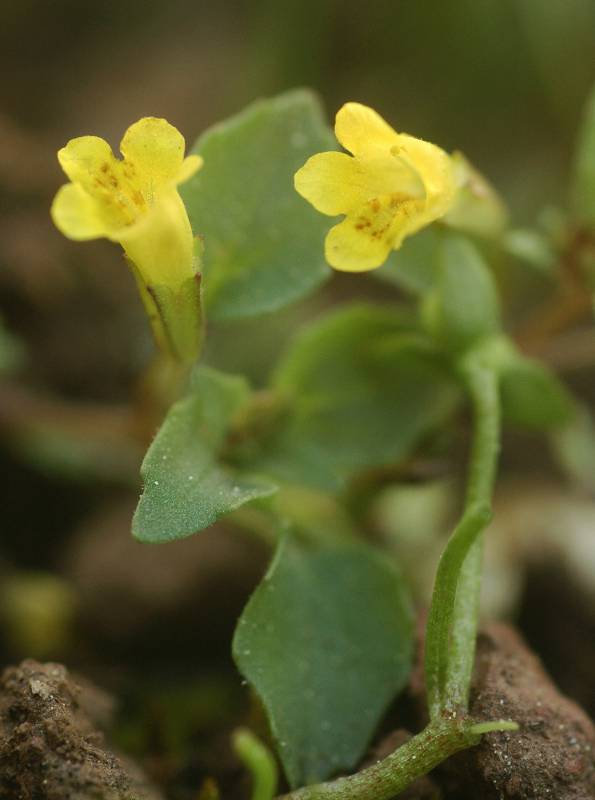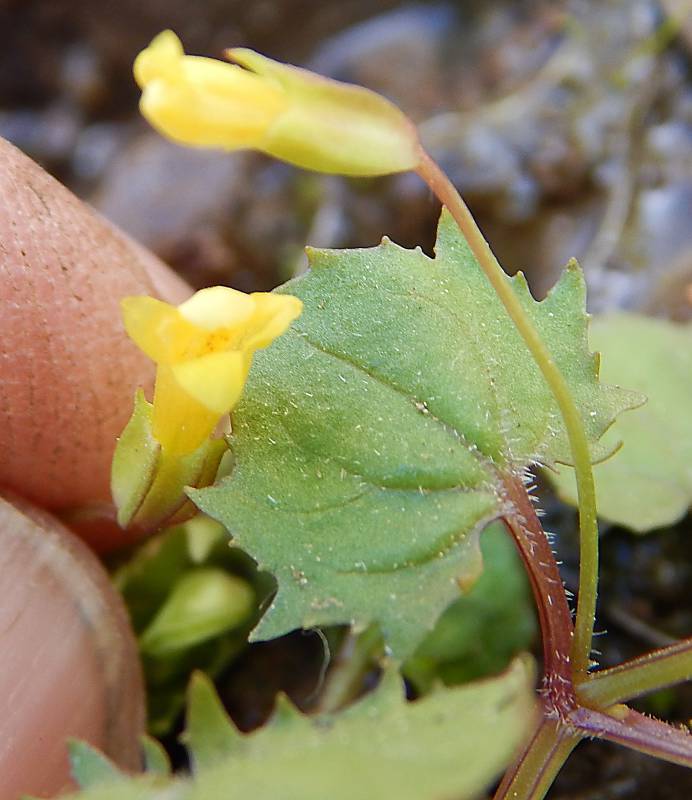Erythranthe patula
Erythranthe nasuta
stalk-leaved monkey-flower
large-nose monkey-flower, snouted monkey-flower
Leaves cauline, basal ones not persistent;
petioles 8-25 mm;
blade deltate or somewhat ovate to lanceolate, approximately 4-12 mm long and 3-10 mm broad, palmate venation with 3 veins, base rounded to cuneate-truncate, margins usually finely toothed, apex acute to obtuse, surfaces glabrous as stems.
Leaves basal and cauline or basal may not persist;
petioles 3-35 mm from base to mid-stem with narrowly flanged bases, becoming sessile distally;
blade reddish or purple-spotted beneath, somewhat ovate to nearly orbicular, approximately 10-49 mm long and 10-25 mm broad, leaves nearest base largest and persistent, palmate venation with 3-5 veins, base cuneate to truncate or nearly cordate, margins irregularly toothed or nearly lacerate, commonly doubly-toothed, 4-9 main teeth per side, sometimes sublacerate to sublyrate near base, apex acute to obtuse, surfaces glabrous or hirtellous with hairs that are dull, cylindrical, sharp-pointed, eglandular.
Axillary flowers 1-10, emerging from nodes throughout; fruiting pedicels 10-25 mm, glandular as stems;
calyx tubular, barely or not inflated, 5-6 mm, margins with distinct teeth or lobes, slightly stipitate-glandular to sparsely hirtellous, lobes pronounced, erect;
corollas yellow, lower limb commonly with some red or brownish dots, symmetric radially or bilaterally, regular or weakly bilabiate;
tube-throat funnel-shaped, 7-8 mm, protruding beyond calyx margin;
lobes oblong, apex rounded to truncate;
styles glabrous;
anthers not protruding, glabrous.
Axillary flowers typically 2-12, emerging from nodes at mid- to ends of stems; fruiting pedicels usually 7-20 mm, longer than subtending leaves, becoming glabrous, occasionally glandular-villous on upper surface at axils;
calyx nodding at 30-180 degrees, commonly purplish or purple-spotted, ovoid-campanulate, inflated, compressed across sagittal plane, usually 10-15 mm, hirtellous or appressed-hirtellous, or glabrous, slightly short-ciliate at sinuses, throat closing, upper lobe generally longer than lower lobe, slightly sickle shaped;
corollas yellow, throat commonly with red spots, lower limb usually with a red splotch at base, symmetric bilaterally, weakly bilabiate;
tube-throat widely cylindric, 8-12 mm, equal to or protruding 1-2 mm beyond calyx margin, limb expanded 6-12 mm;
styles slightly rough or glabrous;
anthers not protruding, glabrous.
Capsules 4-6 mm, included.
Capsules 5-9 mm, included.
Erythranthe patula
Erythranthe nasuta
- Local floras:
BC,
OR,
WA
- Local Web sites:
Flora NW,
PNW Herbaria
WildflowerSearch
iNaturalist (observations)
- LBJ Wildflower Center
- SEINet
- Plants of the World Online
- Encyclopedia of Life
- Wikipedia
- Google Image Search
- Local floras:
BC,
CA,
OR,
WA
- Local Web sites:
CalFlora,
CalPhotos,
Flora NW,
PNW Herbaria
WildflowerSearch
iNaturalist (observations)
- LBJ Wildflower Center
- SEINet
- Plants of the World Online
- Encyclopedia of Life
- Wikipedia
- Google Image Search



